June 7, 2025 | 23:55 GMT +7
June 7, 2025 | 23:55 GMT +7
Hotline: 0913.378.918
June 7, 2025 | 23:55 GMT +7
Hotline: 0913.378.918
Introduction:
The Mekong Delta is a big “rice granary” in the South, contributing over 90% of Vietnam’s export rice output. But on the other hand, this industry accounts for 48% of the agricultural sector’s greenhouse gas emissions. Facing the challenge of climate change and the development of world consumption trends, Vietnam in general and the Mekong Delta in particular are forced to switch to a low-carbon farming method. This approach is soon to be compulsory, because the longer it takes, the higher the cost will be.
This series of articles recorded the journey of efforts of the Mekong Delta’s farmers, cooperatives, businesses, localities and the Ministry of Agriculture and Rural Development in converting agroproduction in the direction of green agriculture, greenhouse gas emissions reduction and sustainable development. The aim is to successfully build a material area of 1 million ha specializing in high-quality rice cultivation associated with green growth in the Mekong Delta.
Looking back at rice production in the 2008 – 2009 period, IR50404 was a popular rice variety and widely grown in the Mekong Delta. With short-term characteristics, wide adaptability, easy care, low investment cost but high yield, suitable for processing, IR50404 was favored among farmers in the area, even helping them make a fortune sometimes.
Following the development trend of the market, after a long time involved in cultivation, IR50404 was no longer suitable when the selling price dropped. The agriculture sector in the Mekong Delta localities was determined to orient rice production from ordinary rice to high-yielding, high economic value rice that meets the requirements of import markets.
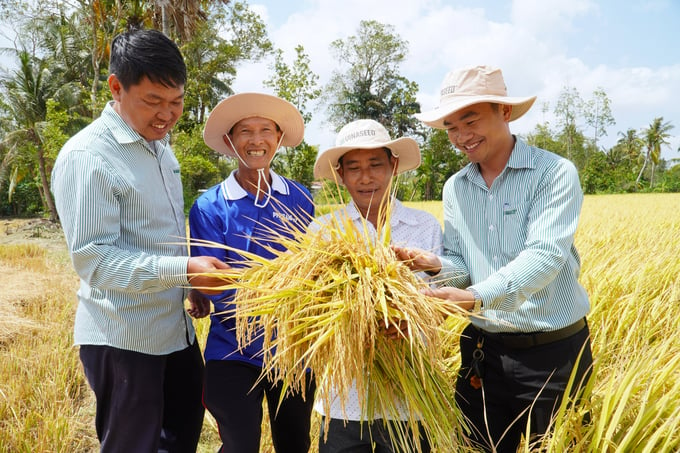
High-quality rice varieties such as OM5451, OM18, Dai Thom 8, ST account for a large proportion of rice production in the Mekong Delta. Photo: Kim Anh.
A "revolution" to develop rice varieties with high economic value in the Mekong Delta began with the birth of rice varieties such as OM7347, OM4900, OM6162. Dr. Tran Ngoc Thach, Director of the Mekong Delta Rice Research Institute, said that these groups of rice varieties laid the foundation for the development of economical rice varieties in the Mekong Delta region.
Since then, a series of high-quality rice varieties have made their appearance, notably the rice variety OM5451. With the ability to adapt to many different soils, short growth periods, and good tolerance to alkaline water conditions, OM5451 was well-received among the farmers and quickly planted in many Mekong Delta provinces and cities.
A report by the Vietnam Food Association shows that the structure of Vietnam's rice exports is shifting to fragrant and high-quality rice. In 2022 alone, the market share of fragrant rice of all kinds increased sharply. OM5451 experiences the strongest increase with an export volume of nearly 1.2 million tons, up more than 48% over the same period.
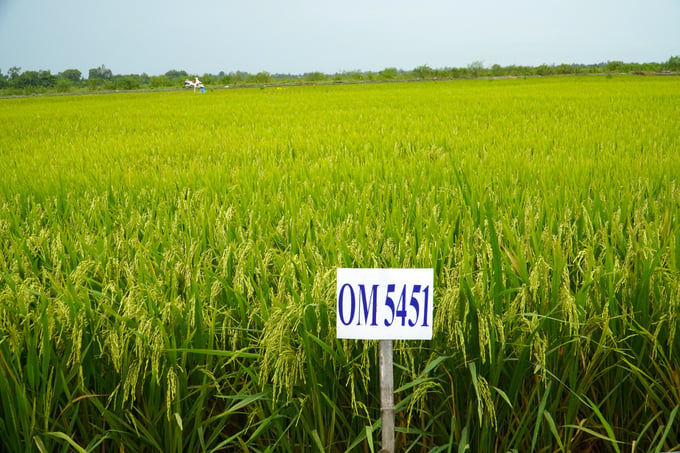
The birth of the rice variety OM5451 created a revolution, which was followed by the appearance of many rice varieties with high economic value in the Mekong Delta. Photo: Kim Anh.
The OM rice varieties bred by the Mekong Delta Rice Institute are commonly grown and account for a large proportion of the export rice structure. The main varieties are OM5451 and OM18 with annual planting areas from 750,000 to 850,000 ha. These two rice varieties alone contribute approximately 70% of Vietnam's rice exports today.
Thanks to strong investment in efforts and resources in breeding high quality rice, the Mekong Delta now has more rice varieties to meet export requirements and satisfies the tastes of consumers. Apart from OM5451, rice varieties like OM18, Dai Thom 8, and ST varieties are also asserting a strong foothold in the export market, having the leading export volume and the proportion of exports experiencing outstanding increase over the years.
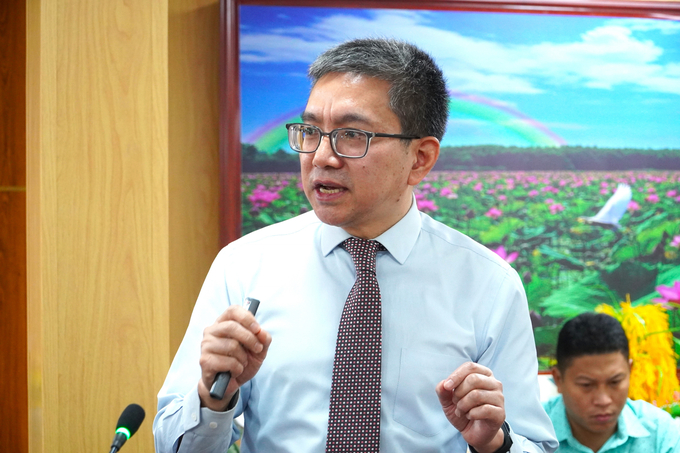
Mr. Li Guo, a senior agriculture expert at the World Bank highly appreciated Vietnam's ST25 rice brand. Photo: Van Vu.
Rice varieties with high economic value dominate in terms of agroproduction
In 20 years, the group of rice varieties with high economic value has become the mainstay in the Mekong Delta’s rice production structure. Typically in Kien Giang province, in the two main rice crops in 2013, the province sowed seeds on a scale of 60,000 ha using high quality rice varieties such as OM4900, OM6976, Jasmine 85, concentrated in the districts of Hon Dat, Chau Thanh, Tan Hiep, Giong Rieng, Go Quao and Rach Gia city.
Mr. Le Huu Toan, Deputy Director of Kien Giang Department of Agriculture and Rural Development, said that in the province's seed structure in many past crops, high-quality rice varieties were used up to over 95%. Kien Giang has a large rotation in terms of rice varieties that are popular in the export market and high demand towards ST24, ST25 and OM18.
Farmers are very conscious of organizing high-quality rice production so that many businesses would come for purchase, thus creating momentum for the province's large field area to experience a sudden increase, with more than 20 businesses implementing consumption linkages. Among them, 3 large corporations have signed a memorandum of understanding, diverging from 2021 to 2025, with nearly 25% of rice production area linked to consumption.
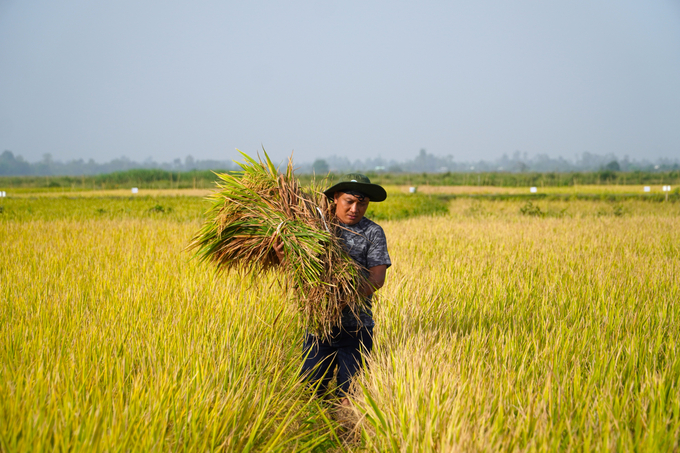
Farmers pay close attention to high-quality rice production organization, applying advanced and environment-friendly farming processes, and establishing consumption linkage with enterprises to improve the value of rice seeds. Photo: Van Vu.
Mr. Tran Anh Thu, Vice Chairman of An Giang People's Committee, said, “By 2025 the province will maintain sowing rice from 550,000 to 600,000 ha, and at the same time planning a large-scale concentrated rice and sticky rice growing area, developing approximately 100,000 ha specializing in high-quality rice cultivation in association with enterprises”.
An Giang is striving for 70-80% of the high-quality rice area to be granted a planting area code that meets export standards. The province's agricultural sector is currently implementing a number of projects to create breakthroughs for rice production, with the highlight being the “Scheme on building and developing rice brands in An Giang province to 2025 - vision to 2030”. The scheme’s goal is to support farmers and cooperatives to build An Giang’s signature trademarks and rice brands. In the not-too-distant future, on this land called "the dead land revived", a green, sustainable, circular, emission-reducing rice chain will be formed.
The fourth Global Conference of the Sustainable Food Systems Programme is scheduled to be held from April 24 to 28 in Hanoi. The event receives attention from many ministers, deputy ministers, and heads of sectors from countries and international organizations.
The 4th global conference of the Sustainable Food Systems Programme will contribute to the 2023 Stocktaking Moment of the UN Food Systems Summit follow-up process by focusing on how food systems need to be transformed to overcome the multiple deeply rooted and interlinked crises of climate, biodiversity, conflict, energy, prices, hunger, malnutrition, and health to achieve the sustainable development goals (SDGs).
As the host country of the fourth conference, Vietnam will have the opportunity to share with other countries, United Nations organizations and international organizations about the efforts, results and the process of Vietnam's food system transformation.
The opening session is scheduled to be held on the morning of April 24, followed by thematic sessions. The SFS Program's closing meeting and the Multi-Stakeholder Advisory Committee (MAC) are scheduled to be held on the afternoon of April 27 and the morning of April 28.
For more information, please visit the links below:
https://www.oneplanetnetwork.org/programmes/sustainable-food-systems/4thconference
https://nongnghiepmoitruong.vn/hoi-nghi-toan-cau-he-thong-lttp-channel46/
Translated by Samuel Pham
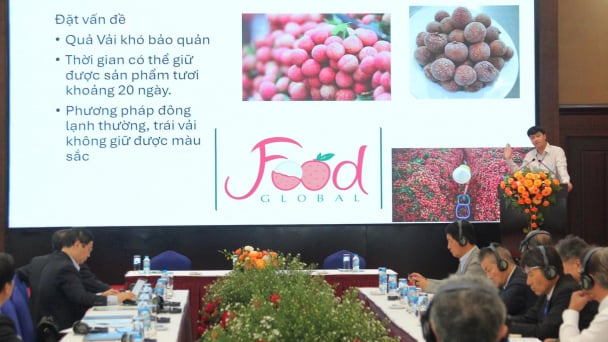
(VAN) VAAS and numerous Vietnamese enterprises have signed cooperation agreements with Japanese partners to promote agricultural technology and trade connectivity.
/2025/05/29/5625-12-214801_567.jpg)
(VAN) Provincial mergers in the Mekong Delta promise to streamline administration, expand inter-provincial raw material areas, and foster close linkages in agricultural value chains, benefiting both businesses and cooperatives.
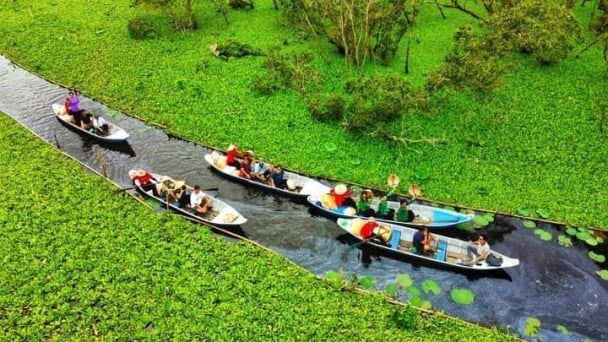
(VAN) Merging Mekong Delta provinces contributes to the expansion of agricultural raw material areas, addressing previous constraints caused by provincial boundaries. Additionally, this expansion will reduce costs and strengthen linkages between businesses, cooperatives, and farmers.
/2025/05/29/1043-2-153730_145.jpg)
(VAN) The Government's policy to merge provincial-level administrative units opens up major opportunities for the Mekong Delta region to reshape its agricultural development strategy toward large-scale production, effective regional linkages, and sustainability.
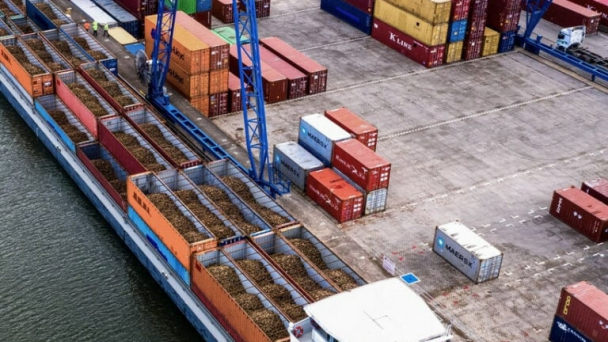
(VAN) The mutual export of agrifood products between the European Union (EU) and the United Kingdom (UK) must occur again without certification, border controls or other red tape. This was agreed at the UK-EU summit.
/2025/05/22/5121-2-173645_677.jpg)
(VAN) NBSAP Tracker identifies strengths and areas for improvement in the National Biodiversity Strategy, based on each region’s priorities and capacities.
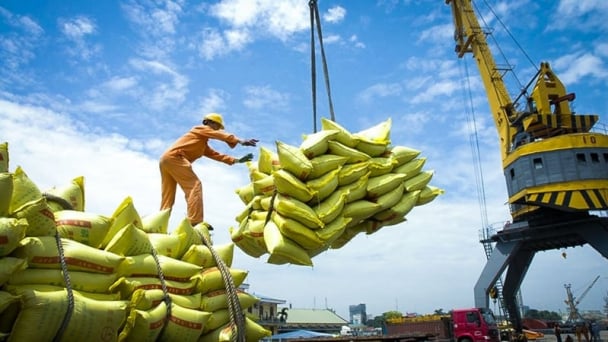
(VAN) The draft amendment to the Circular on rice export trading stipulates a periodic reporting regime for rice exporting enterprises.